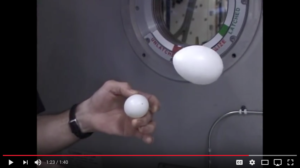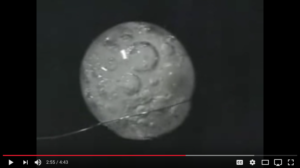Visualizations > Online Video > Microgravity physics
ISS
Dancing T-handle in zero-g, HD
YouTube: uploaded on Mar 2, 2009 – HD video of the installation handle on Space-DRUMS in free floating rotation showing a bi-stable state due to intermediate moments of inertia.
Explanation: “What Is Going on with This Object Spinning in Zero Gravity?”
… the video … shows an astronaut spinning a T-handle in the SpaceDRUMS (Space Dynamically Responding Ultrasonic Matrix System) facility aboard the ISS, … For those of us who aren’t physicists, what’s going on here? Our friend Henry Reich from MinutePhysics actually discusses it in the video below, when he was lucky enough to ask astronaut Scott Kelly to demonstrate it using a Leatherman tool. He calls it the “instability of rotation around the intermediate axis of an object” [tennis racket theorem or intermediate axis theorem], and explains that if you rotate an object around its largest and smallest axes, it will spin in a stable, consistent manner.

Rotating Solid Bodies in Microgravity
YouTube: uploaded on Feb 12, 2008 – Saturday Morning Science [see also Science Friday re moment of inertia].
[NASA astronaut Don Pettit] Here we have a rectangular solid rotating about one of its axes. There’s a minimum moment of inertia and a maximum moment of inertia, and it will spin stably about either of these axes. If you spin it about its intermediate moment of inertia, it will not spin stably, as we see here.
Now what about a cylinder? Here we have a solid cylinder, and it will spin stably about its long axis. Again another solid cylinder, give it an axial spin — it spins stably. Here is a liquid-filled cylinder. An axial spin and it will not spin stably — it will change its axis of rotation and tumble end over end. Here is another liquid filled cylinder and again it will not spin stably about its long axis — it will change its axis of rotation and start tumbling end over end. Here is a long cylinder and it is liquid filled, and it spins stably about its long axis until of course it impacts a hatch.
What do you think would happen if you were to spin a fresh egg and a hard boiled egg? Only they’re not confined to a tabletop. We’re going to do this and see if you could see the difference. One of these is a fresh egg; one of these is a hard-boiled egg [actually one is an empty shell and the other a water-filled shell]. So, will future space colonists be able to tell the difference between their fresh eggs and their hard-boiled eggs by giving them a spin?

Alka-Seltzer added to water spheroid in microgravity
YouTube: uploaded on Nov 7, 2006 – Saturday Morning Science: Alka-Seltzer added to spherical water drop in microgravity onboard the International Space Station.
(March 22, 2003) Expedition Six NASA ISS Science Officer Don Pettit performs a series of microgravity experiments with water spheres and effervescent antacid tablets. In the second of four videos, Pettit inserts a tablet into a 50-millimeter [diameter] sphere and observes the fizzy results [heterogeneous nucleation].
[Don Pettit] “We have a solid which in this case is a effervescent antacid tablet and this will be added to this 50 millimeter diameter sphere of water where the water will typically react with the effervescent antacid tablet and produce bubbles of carbon dioxide gas, and these bubbles will form on the surface of the antacid tablet and that presents a heterogeneous system where the bubbles can be popped off the surface with some momentum — as opposed to bubbles that just nucleate within the body of a liquid like when you open up a bottle of soda pop. … First time I did this, I had no idea what was going to happen. I had a couple of preconceived ideas and both of those were wrong. Well, that’s what science is all about — it goes to show that sometimes you just have to do an experiment in order to figure out what’s gonna happen. … the bubbles are being kicked off of a solid surface … they rapidly collapse and make bigger bubbles and then these big bubbles start to swallow up other bubbles as the chemical reaction proceeds until ultimately you’re left with two or three large bubbles with cords of little tiny bubbles; and as a chemical reaction proceeds, it starts to slow down — there’s no longer enough kinetic energy to cause the bubbles to coalesce, and here you can see we basically have two great big bubbles that form this bipolar arrangement. It seems fairly stable — a situation like this will last for some time, and … here all the little bubbles have been pushed in the spaces between the two big bubbles. Now … one of the bubbles was popped and so now we have a sphere — it’s basically hollow inside, it’s a big gas bubble inside, it’s got some thickness to it with a whole bunch of little tiny bubbles swimming around. This was so interesting …”

Symphony of Spheres in Microgravity
Sphere of air surrounded by sphere of water – dynamics of injecting air or water droplets into bubble
Uploaded on Feb 12, 2008 – Saturday Morning Science
